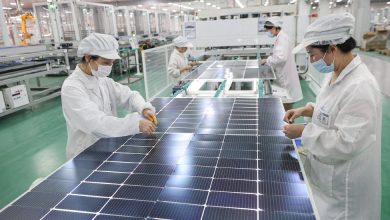Wages are rising, but can they keep up with inflation?

American workers are taking home bigger paychecks as employers pay up to attract and retain employees. But those same people are shelling out more for furniture, food and many other goods and services these days.
It is not yet clear which side of that equation — higher pay or higher prices — is going to win out, but the answer could matter enormously for the Federal Reserve and the White House.
There are a few ways this moment could evolve. Wage growth could remain strong, driven by a tight labor market, and overall inflation could simmer down as supply chain snarls unravel and a surge in demand for goods eases. That would benefit workers.
But troubling outcomes are also possible, and high on the list of worries is what economists call a “wage-price spiral.” Employees could begin to demand higher pay because they need to keep up with a rising cost of living, and companies may pass those labor costs on to their customers, kicking off a vicious cycle. That could make today’s quick inflation last longer than policymakers expect.
The stakes are high. What happens with wages will matter to families, businesses and central bankers — and the path ahead is far from certain.
“It’s the several-trillion-dollar question,” said Nick Bunker, director of research for the hiring site Indeed.
For now, wage growth is rapid — just not fast enough to keep up with prices. One way to measure the dynamic is through the Employment Cost Index, which is reported by the Labor Department every quarter. In the year through September, the index’s measure of wages and salaries jumped by 4.2 percent. But an inflation gauge that tracks consumer prices rose by 5.4 percent over the same period.
A different measure of pay, an index that tracks hourly earnings, did rise faster than inflation in August and September after lagging it for much of the year.
And an update to that gauge, set for release in the jobs report on Friday, is expected to show that wages climbed 0.4 percent in October, which is roughly in line with recent monthly price increases. But the data on hourly earnings have been distorted by the pandemic, because low-wage workers who left the job market early in 2020 are now trickling back in, jerking the average around.
The upshot is that the tug of war between price increases and pay increases has yet to decisively swing in workers’ favor.
Whether wage gains eventually eclipse inflation — and why — will be crucial for economic policymakers. Central bankers celebrate rising wages when they come from productivity increases and strong labor markets, but would worry if wages and inflation seemed to be egging each other upward.
The Federal Reserve is “watching carefully,” for a troubling increase in wages, its chair, Jerome H. Powell, said on Wednesday, though he noted that the central bank doesn’t see such a trend shaping up right now.
Recruiters do report some early signs that inflation is factoring into pay decisions. Bill Kasko, president of Frontline Source Group, a job placement and staffing firm in Dallas, said that as gas prices in particular rise, employees are demanding either higher pay or work-from-home options to offset their increased commuting costs.
“It becomes a topic of discussion in negotiations for salary,” Mr. Kasko said.
But for the most part, today’s wage gains are tied to a different economic trend: red-hot demand for workers. Job openings are high, but many would-be employees remain on the labor market’s sidelines, either because they have chosen to retire early or because child care issues, virus concerns or other considerations have dissuaded them from working.
Emily Longsworth Nixon, 27 and from Dallas, is one of Mr. Kasko’s employees. She tried to recruit a woman to an executive assistant position at a technology company that would have given her a $30,000 raise — and saw the candidate walk away for a counter offer of no additional pay but three work-from-home days each week.
Understand the Supply Chain Crisis
Covid’s impact on the supply chain continues. The pandemic has disrupted nearly every aspect of the global supply chain and made all kinds of products harder to find. In turn, scarcity has caused the prices of many things to go higher as inflation remains stubbornly high.
Almost anything manufactured is in short supply. That includes everything from toilet paper to new cars. The disruptions go back to the beginning of the pandemic, when factories in Asia and Europe were forced to shut down and shipping companies cut their schedules.
First, demand for home goods spiked. Money that Americans once spent on experiences were redirected to things for their homes. The surge clogged the system for transporting goods to the factories that needed them — like computer chips — and finished products piled up because of a shortage of shipping containers.
Now, ports are struggling to keep up. In North America and Europe, where containers are arriving, the heavy influx of ships is overwhelming ports. With warehouses full, containers are piling up at ports. The chaos in global shipping is likely to persist as a result of the massive traffic jam.
No one really knows when the crisis will end. Shortages and delays are likely to affect this year’s Christmas and holiday shopping season, but what happens after that is unclear. Jerome Powell, the Federal Reserve chair, said he expects supply chain problems to persist “likely well into next year.”
“After that I had my tail between my legs for a couple of days; I had never thought to ask that,” she said, explaining that employers need to know their candidates like never before as workers flex their power, taking home raises and other perks. “Before Covid, it was an employer-driven market.”
Those in-demand workers could end up being better off in the long run, should their pay continue to chug higher even as supply chains heal and prices for used cars and couches moderate, allowing them to afford more.
Pay gains might also become more sustainable for employers as virus concerns fade and employees trickle back from the labor market’s sidelines.
And even if rapid wage increases persist, it is not absolutely the case that employers will be forced to drastically raise prices. Businesses could stomach a hit to their profits instead, or they could invest in technology that improves worker productivity.
If fewer waitresses can sell the same number of dinners because customers are ordering from QR codes, for instance, employers will have leeway to pay more without taking a hit to their bottom line.
But a happy outcome is not guaranteed. If today’s high prices do drive tomorrow’s wage negotiations and set off an upward spiral, the result could be a longer period of high inflation that prods the Fed to raise interest rates to tamp down demand and cool off prices, slowing the economy and possibly even sending it back into a recession.
A scenario like that hasn’t taken place since the 1970s and 1980s. But then, a situation like the pandemic lockdowns and subsequent reopening has never happened at all.
“We haven’t seen a wage-price spiral for decades, but we haven’t seen inflation like this for decades, either,” said Jason Furman, a Harvard University economist and former economic adviser in the Obama administration, calling the possibility of a wage-driven spiral “an open question.”




